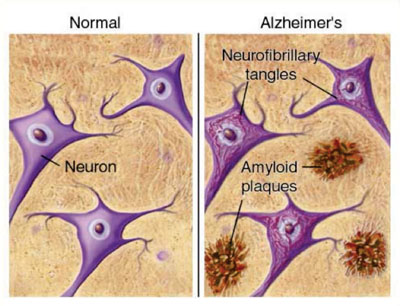Plasma Levels Investigated as Alzheimer's Disease Biomarkers
By LabMedica International staff writers
Posted on 04 May 2016
The relationship between plasma levels of two amyloid beta peptides (Aβ1-40 and Aβ1-42), brain volumetrics and cognitive performance has been investigated.Posted on 04 May 2016
Since amyloid beta (Aβ) peptides are the main component of the amyloid plaques found in Alzheimer patients' brains, changes in levels of Aβ in blood plasma may provide a biomarker for detecting increased risk or early diagnosis of disease.

Image: A diagram of the formation of amyloid plaques in the brain of an Alzheimer brain compared with a normal brain (Photo courtesy of Junji Takano).
Scientists at the University of New South Wales (Sydney, Australia) examined 126 age-matched cognitively normal controls, 89 individuals with amnestic mild cognitive impairment (aMCI,) from the Center for Healthy Brain Aging (CHeBA) Sydney Memory & Aging Study (Sydney MAS), as well as 39 individuals with Alzheimer's disease (AD) recruited from a specialty clinic.
Sydney MAS participants underwent brain Magnetic resonance imaging (MRI) scans and were assessed on 19 cognitive measures and were apolipoprotein E (APOE ε4) genotyped. Plasma levels of Aβ1-40 and 1-42 were quantified using enzyme-linked immunosorbent assay (ELISA). Plasma levels of the two peptides and the Aβ1-42/1-40 ratio were lower in aMCI and Alzheimer's disease than in cognitively normal controls, and lower levels of Aβ1-42 were associated with lower global cognition and hippocampal volume and higher levels of white matter hyperintensities, which are believed to contribute to Alzheimer's disease.
A genetic component was also identified, with associations between Aβ1-40 and cognitive and brain volume measures predominantly observed in individuals carrying the ε4 allele, while the opposite was observed in non-carriers. Longitudinal analysis revealed greater decline in global cognition and memory for the highest quintiles of Aβ1-42 and the ratio measure. The relationships of Aβ1-40 and Aβ1-42 were predominantly observed in ε4 allele carriers and non-carriers respectively.
The authors concluded that Plasma Aβ levels and the Aβ1−42/1-40 ratio are related to cognition and hippocampal volumes, with differential associations of Aβ1-40 and Aβ1-42 in ε4 carriers and non-carriers. These data support the Aβ sink model of AD pathology, and suggest that plasma Aβ measures may serve as biomarkers of AD. Anne Poljak, PhD, the lead author of the study, said, “While Aβ has traditionally been measured using cerebrospinal fluid, plasma presents a more accessible sample for routine collection and screening although results to date have been variable.” The study was published on April 18, 2016, in the journal Current Alzheimer Research.
Related Links:
University of New South Wales














